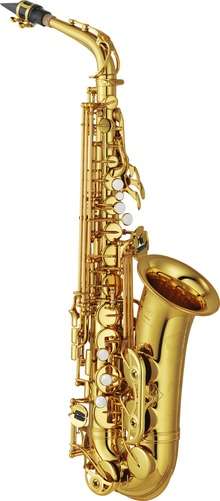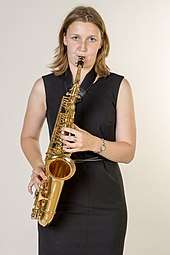Alto saxophone
The alto saxophone, also referred to as the alto sax or alto, is a member of the saxophone family of woodwind instruments invented by Belgian instrument designer Adolphe Sax in the 1840s, and patented in 1846. It is pitched in E♭, and is smaller than the tenor, but larger than the soprano. The alto sax is the most common saxophone and is commonly used in concert bands, chamber music, solo repertoire, military bands, marching bands, and jazz (such as big bands, jazz combos, swing music). The fingerings of the different saxophones are all the same so a saxophone player can play any type of saxophone.
 | |
| Woodwind instrument | |
|---|---|
| Classification | |
| Hornbostel–Sachs classification | 422.212-71 (Single-reeded aerophone with keys) |
| Inventor(s) | Adolphe Sax |
| Developed | 28 June 1846[1] |
| Playing range | |
 In E♭: sounds a major sixth lower than written. Most modern alto saxophones can reach a high F♯ (or higher using altissimo fingerings). | |
| Related instruments | |
|
Military band family:
Orchestral family:
Other saxophones:
| |
| Musicians | |
| |
| More articles | |
The alto saxophone had a prominent role in the development of jazz. Influential jazz musicians who made significant contributions include Don Redman, Jimmy Dorsey, Johnny Hodges, Benny Carter, Charlie Parker, Sonny Stitt, Lee Konitz, Jackie McLean, Phil Woods, Art Pepper, Paul Desmond, and Cannonball Adderley.
Although the role of the alto saxophone in classical music has been limited, influential performers include Marcel Mule, Sigurd Raschèr, Jean-Marie Londeix, Eugene Rousseau, and Frederick L. Hemke.
Range
The range of the alto saxophone is from concert D♭3 (the D♭ below F—see Scientific pitch notation) to concert A♭5 (or A5 on altos with a high F♯ key). When necessary, a player can extend the instrument's range to concert C3 by putting their knee or foot in the bell.[2] As with most types of saxophone, the standard written range is B♭3 to F6 (or F♯6).[3] Above that, the altissimo register begins at F♯6 (or G6) and extends upwards. The saxophone's altissimo register is more difficult to control than that of other woodwinds and is usually only expected from advanced players.
Alto saxophonists

Notable jazz alto saxophonists include Charlie Parker, Cannonball Adderley, Kenny Garrett, Paul Desmond, Benny Carter, Eric Dolphy, Ornette Coleman, Bobby Watson, Marshall Allen, Julius Hemphill, Oliver Lake, Anthony Braxton, Henry Threadgill, Carlos Ward, David Sanborn, Tom Scott, Paquito D'Rivera, John Zorn, Tim Berne, Steve Wilson, Steve Coleman, Greg Osby, Vincent Herring, Mark Gross, and Jeff Coffin.
Notable classical alto saxophonists include Tim McAllister, Jean-Yves Fourmeau, Lawrence Gwozdz, Donald Sinta, Harvey Pittel, Larry Teal, Kenneth Tse, Arno Bornkamp, Harry White, Otis Murphy, Claude Delangle.
Manufacturers
Some companies that currently produce saxophones are Buffet Crampon, KHS/Jupiter, Conn-Selmer, Selmer Paris, Yamaha, Leblanc/Vito, Keilwerth, Cannonball, P.Mauriat Musical Instrument and Yanagisawa. New alto saxophones range in price between €250 ($281.05) for lower quality student models to over €6000 ($6745.20) for professional models.
Classical music repertoire
The alto saxophone has a large classical solo repertoire that includes solos with orchestra, piano and wind symphony. Two important solo compositions are Jacques Ibert's "Concertino da Camera" and Alexander Glazunov's "Concerto in E Flat major".
The alto saxophone is found in the standard instrumentation of concert bands and saxophone quartets. Alexander Glazunov composed his Saxophone Quartet in B-flat major in 1932.
The alto saxophone is sometimes used in orchestral music. Some of the compositions where it appears are listed below.
- Georges Bizet features it in the "Minuet" from the second suite of music from L'Arlésienne.
- It was called for by Richard Strauss in his Sinfonia Domestica, which includes parts for four saxophones including an alto saxophone in F.
- Dmitri Shostakovich uses the alto in his Suite for Variety Orchestra and it has a prominent solo in the "Waltz No. 2" section. He also includes it in his Suite No. 1 and Suite No. 2.
- Maurice Ravel uses the saxophone prominently in his orchestration of Modest Moussorgsky's Pictures at an Exhibition, most notably as the soloist in "Il vecchio castello".
- Alban Berg uses the saxophone in his late orchestral works, most notably "Der Wein", Lulu, and the Violin Concerto.
- Sergei Rachmaninoff uses the saxophone in his Symphonic Dances as a soloist in the first movement.
- George Gershwin includes it in a few pieces; such as Rhapsody in Blue and An American in Paris.
- Pierre Boulez wrote for 2 alto saxes in his composition Pli selon pli ("Fold by Fold").
- Benjamin Britten calls for an alto in his Sinfonia da Requiem and The Prince of the Pagodas.
- Leonard Bernstein includes an alto sax in his Symphonic Dances from West Side Story.
- Vincent d'Indy enlists two altos in his opera Fervaal.
- Darius Milhaud writes for an alto in La Creation du Monde, and places it in the score where we would expect to see a viola.
- Allan Pettersson makes use of an alto in his 16th Symphony.
- Krzysztof Penderecki scores for two altos in his opera The Devils of Loudon ("Die Teufel von Loudon").
- Aram Khatchaturian includes an alto in his ballet Gayane.
- Poul Ruders includes a significant solo for the alto saxophone in his orchestral suite Concerto in Pieces.
- Eric Coates wrote for an alto in his 1936 Saxo-Rhapsody.
- Claude Debussy features an alto in his Rhapsody for Saxophone and Orchestra.
- Paul Creston wrote a concerto for the alto as well as a sonata (with piano), a rapsodie (with organ), and included it in a suite for saxophone quartet.
- Ronald Binge wrote a concerto for the alto saxophone in E-flat major (1956)
- Alan Hovhaness includes an alto in his ballet Is There Survival (also known as King Vahaken) and as part of incidental music he wrote to accompany the play The Flowering Peach.
References
- "June 28, 1846: Parisian Inventor Patents Saxophone". Wired.com. Retrieved 14 February 2011.
- "Playing Notes Lower Than Low Bb". Retrieved 3 March 2020.
- "Range of the Alto Saxophone". Library.thinkquest.org. Archived from the original on 17 March 2009. Retrieved 18 January 2011.